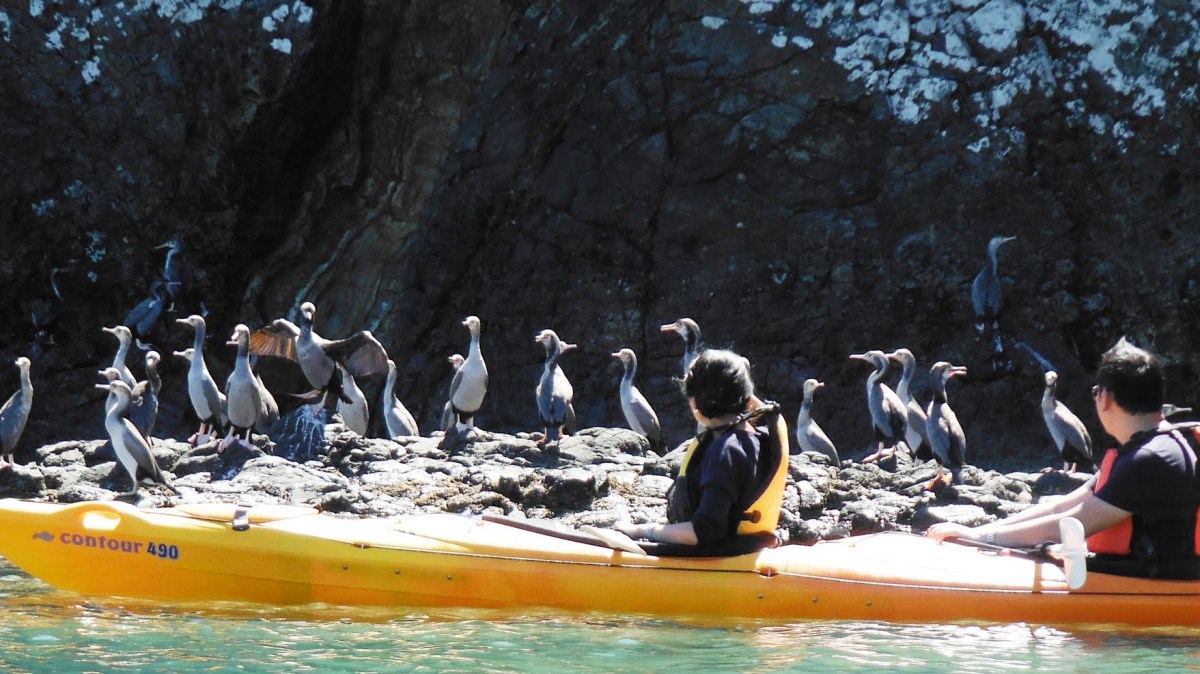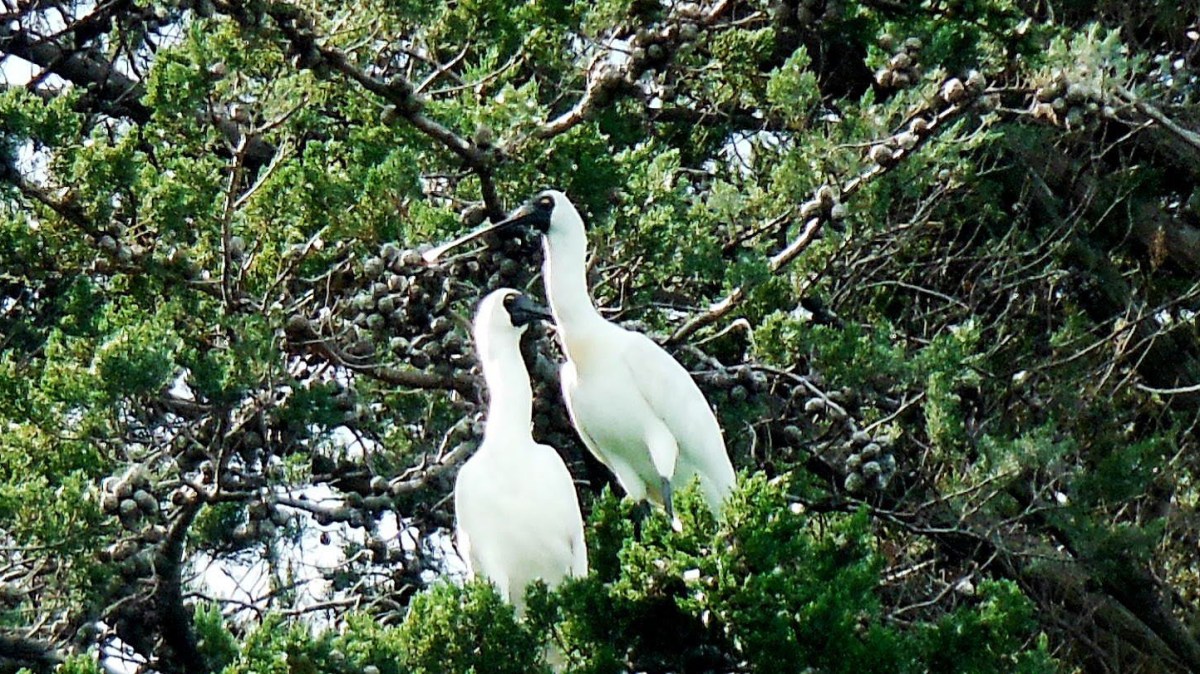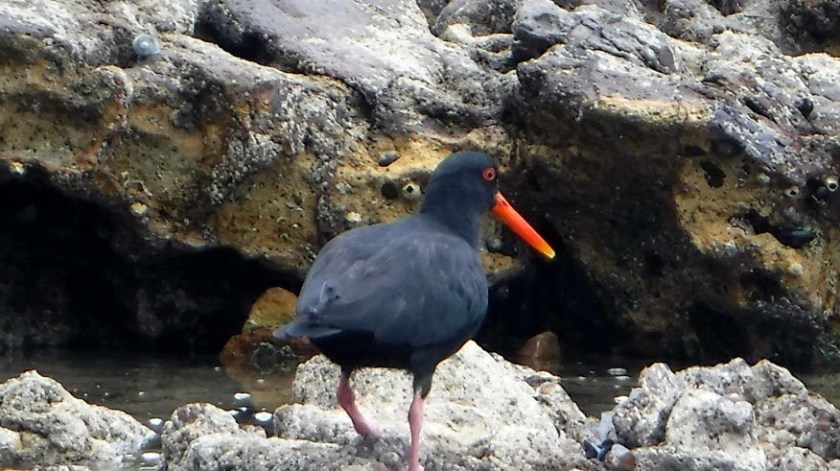A Bird Watcher's Paradise!
If you are an avid bird watcher, or just love seeing birds up close and personal in their own natural habitat going about their daily business, then you will love our sea kayaking safaris! Parts of the shore around our marine reserve is conservation land and a thriving sanctuary to many native New Zealand birds.
You are likely to see …
South Island pied oyster catcher, paradise shell ducks, black backed gull, red billed gull, white fronted tern, kereru ( NZ wood pidgeon) white faced heron, NZ kingfisher, spur winded plover and more! Read below for more info on some of our favourite birds.
A Shag on a rock…
Many New Zealanders have seen a long-necked shag sitting on a rock, or flying like an arrow above the sea. Worldwide there are 36 species of shag, and 12 of these are found in New Zealand. They are fully protected by law, except for the black shag.
Shags live mostly by the sea, but also near lakes and rivers. Around New Zealand there are many colonies, some with several thousand birds. Here in Akaroa we are lucky enough to view many different varieties!


What Do Shags Eat?
Some shags eat food from the sea, and others from fresh water, or a mixture of both. Their diet includes fish, crayfish and frogs. Diving for their prey, they chase it underwater, where they can last several minutes without air. Afterwards some species spread their wings in the sun, to dry out quickly.
Royal Spoonbill – Kōtuku-ngutupapa
The royal spoonbill has a long flat bill with a spoon-shaped tip. In the same family as ibises, it is a stork-like bird with long legs and neck. The royal spoonbill or kōtuku-ngutupapa is a self-introduced native; yellow-billed spoonbills also occasionally visit New Zealand.
The royal spoonbill is white with a black bill, face and legs. It measures about 77 centimetres from bill tip to tail, and weighs 1.7 kilograms. During breeding, pale-yellow breast feathers form, and long plumes behind the head are raised during courtship displays.
What Do Royal Spoonsbills Eat?
To feed, spoonbills stand knee-deep in water, sweeping their bill from side to side in wide arcs. This creates swirls, drawing in small invertebrates, fish or frogs from the surrounding water or muddy bottom. Spoonbills sense their prey by touch, feeding by day or night whenever the tide is right.
Royal spoonbills breed at about a dozen coastal sites, some of them near kōtuku, shag and gull colonies. Some nests are high in kahikatea trees, others on low shrubs or on the ground. After breeding they disperse to estuaries and wetlands around the country, Small flocks fly in a V formation.
Oyster Catcher
Oystercatcher occur around most of the coastline of New Zealand, and breed most commonly on sandy beaches, sandspits and in dunes. They are very vocal, you will hear them before you see them! Chicks are warned of danger with a sharp, loud ‘chip’ or ‘click’ sound
Appearance
Adults have black upperparts, their underparts vary from all black, through a range of ‘smudgy’ intermediate states to white. The proportion of all-black birds increases as you head south.
They have a conspicuous long bright orange bill (longer in females), and stout coral-pink legs; their eyes have a red iris and the eye-ring is orange.

The pied morph (the form that has both dark and light colours) of the variable oystercatcher can be confused with the South Island pied oystercatcher.
What Do Oyster Catchers Eat?
Variable oystercatchers eat a wide range of coastal invertebrates, including molluscs and crustaceans which they open either by pushing the tip of the bill between shells and twisting, or by hammering. They occasionally eat small fish and a range of terrestrial invertebrates, including earthworms.
They breed in monogamous pairs and defend territories vigorously against neighbours. Nests are normally simple scrapes in the sand and the 2–3 eggs are laid from October onwards. Incubation is shared and takes about 28 days.
The chicks fly at 6–7 weeks old and late chicks may not fledge until March. Chicks are vigorously protected by both parents, often well after fledging. Adults show high fidelity to their mate and the site.
You Can Help!
-
Call 0800 DOC HOT (0800 362 468) immediately if you see anyone catching, harming or killing native wildlife. This is a FREE call when travelling in NZ
Help protect our native birds
When visiting parks, beaches, rivers, and lakes
- Only take dogs to areas that allow them, and keep them under control.
- Check for pests when visiting pest-free islands.
- Leave nesting birds alone and DO NOT try to get close for selfies, especially when penguins are returning to their nests.
- Use available access ways to get to the beach.
- Avoid leaving old fishing lines on beaches or in the sea.
- Follow the water care code and local navigation bylaws.
- Don’t drive on riverbeds, or keep to formed tracks if you have to.
Other ways to help
- Get your dog trained in avian awareness.
- Volunteer to control predators and restore bird habitats.
- Set predator traps on your property.
- Put a bell on your cat’s collar and feed it well.
